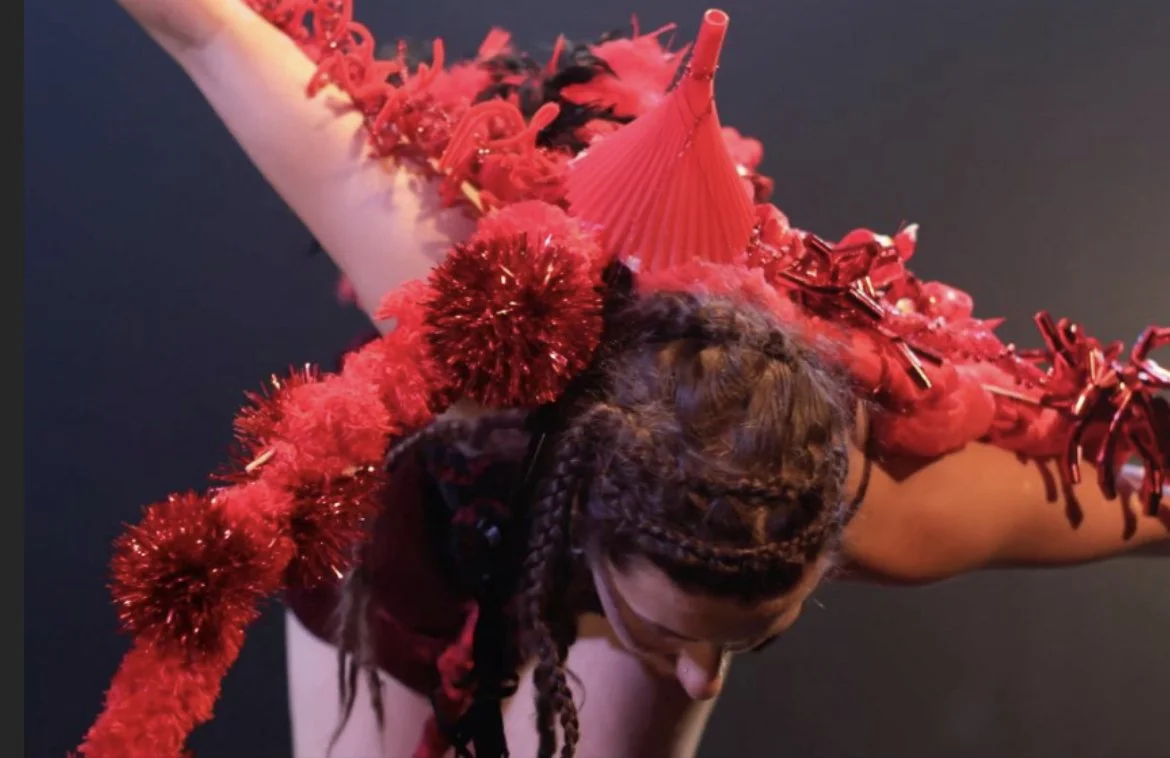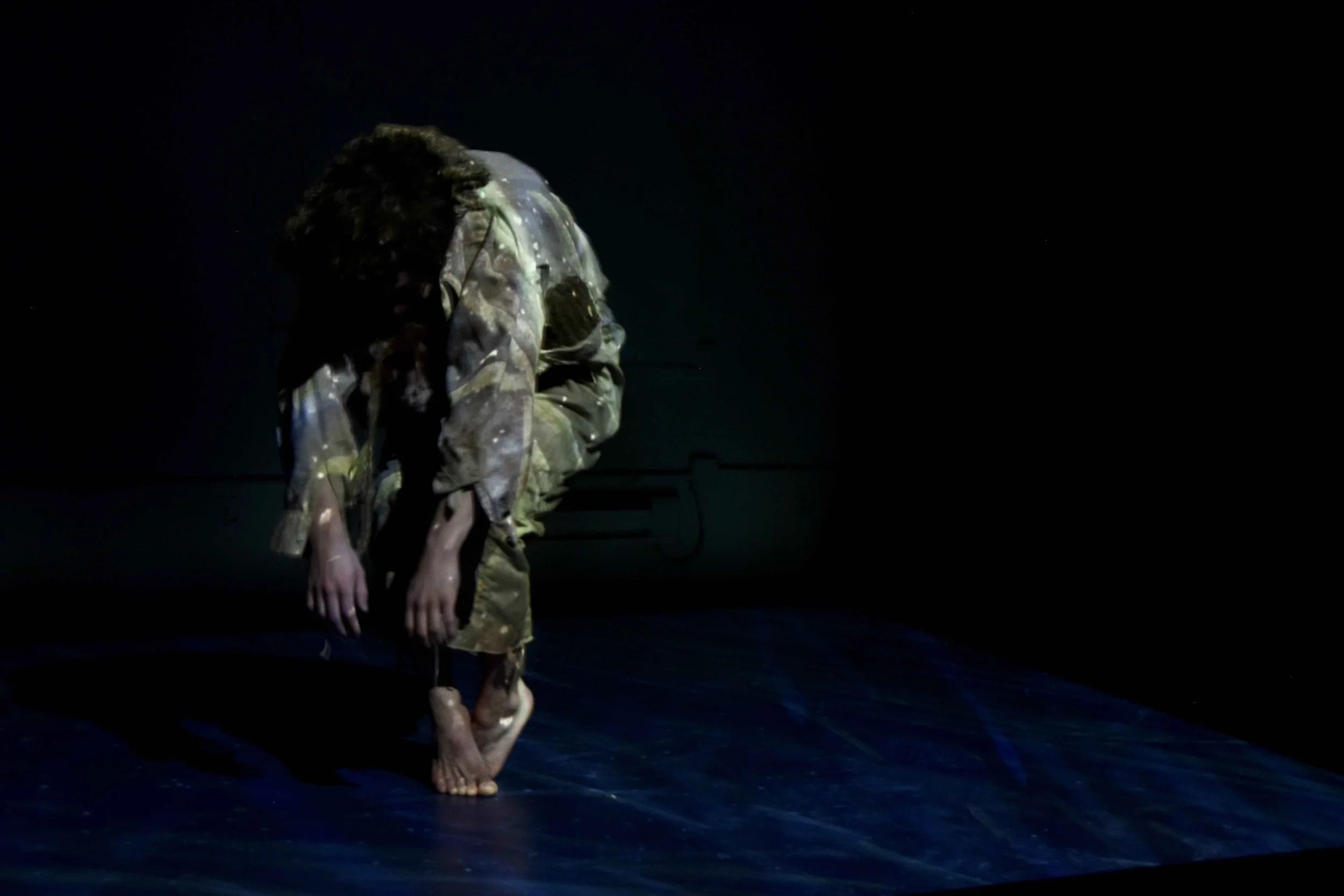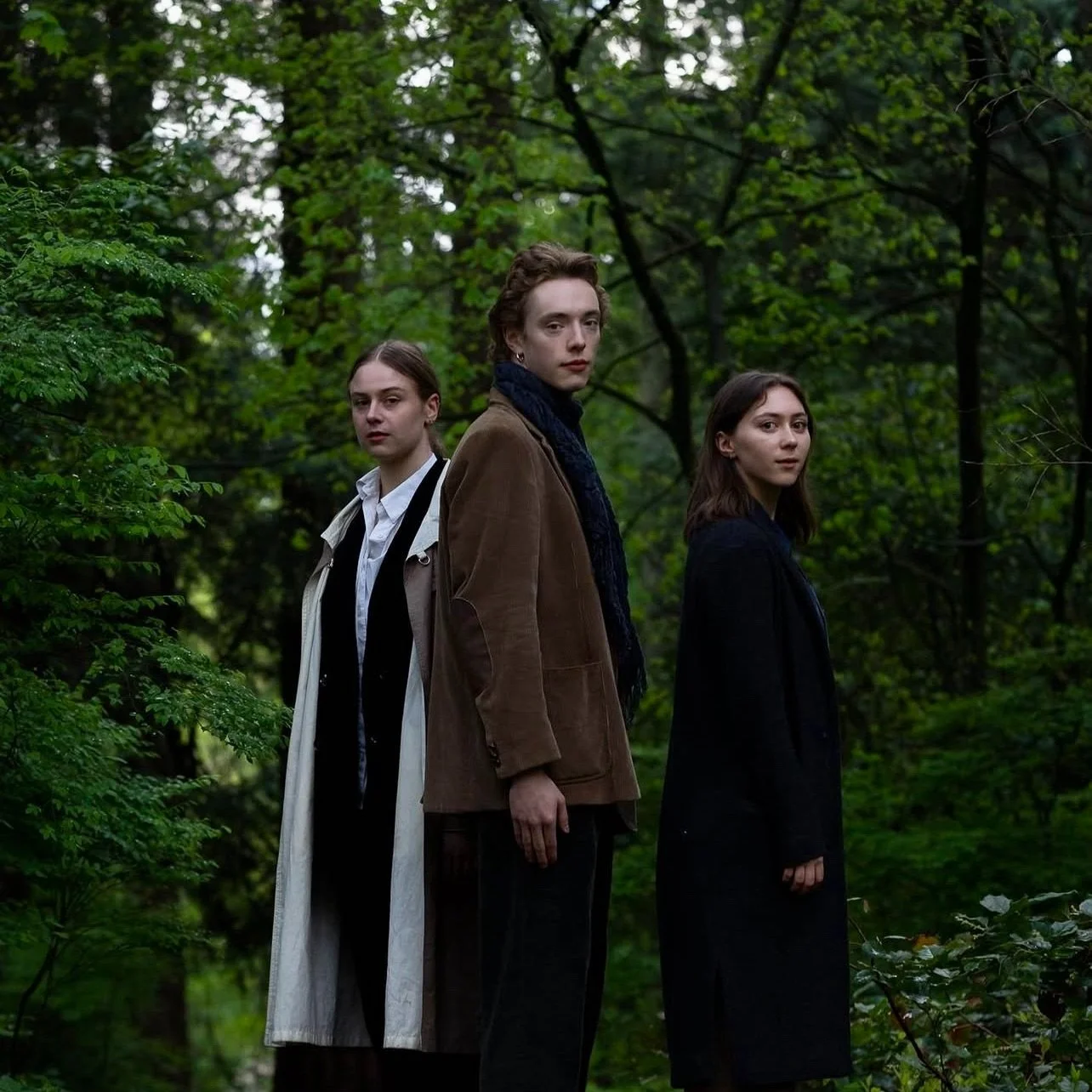Stir Q&A: Meet the 3 choreographers of Dance West Network's Re-Centering/Margins creative residencies
Sophie Dow, Nick Miami Benz, and Jennifer Aoki will showcase work developed over eight months
Sophie Dow. Photo by Vitantonio Spinelli
Dance West Network and SFU Woodward’s present Re-Centering/Margins on April 20 at SFU’s Goldcorp Centre for the Arts, Fei and Milton Wong Experimental Theatre at 7:30 pm, with a postshow talk. Artists share performance clips and in conversation online on May 4, 2 pm to 3:30 pm via dancewest.net.
A TRIO OF emerging contemporary-dance artists of colour are getting ready to show the fruits of eight months of research and creation.
Jennifer Aoki, Nick Miami Benz and Sophie Dow have been taking part in Dance West Network’s unique Re-Centering/Margins Creative Residency—a third annual project that supports the professional development of emerging BIPOC dance artists, pairing them with both a mentor for feedback and an emerging writer of colour to document their process.
Stir asked this year’s three artists, who showcase their creations on April 20, about their experience.
SOPHIE DOW
Winnipeg-born Sophie Dow is a multidisciplinary creative, inspired by dance, music, collaboration and Métis-Assiniboine + settler roots. An avid adventurer, Sophie has a passion for busking, yoga and travelling on top of holding a degree in DancePerformance and Choreography from York University. She’s performed with Chimera Dance Theatre, Kaeja d'Dance, adelheid’s re:research, Carol Anderson, and Jeanette Kotowich. She’s also choreographed and performed in the opening ceremonies of the Shambhala Music Festival. Her mentors were Cole Alvis and Olivia C. Davies; she worked with writer Robyn Grant-Moran.
Tell me a little about the eight-month residency, what it allowed you to explore, or what “eureka” moment you may have had in the studio.
This eight-month residency was fabulous. It really allowed me the time to dig into certain pockets of my choreographic inquiries and pick apart some questions that I may not have gone as in-depth with previously. I worked with a schedule where I spent a couple long focused weeks in the studio, took a few weeks off to reflect, touched base with my mentor and then repeated that twice. I've learned that this is a particularly salient and fruitful way of working for me.
What new territory did working with the mentor and writer allow you to investigate, and how did it influence the work?
My mentor Cole really pushed me in the dramaturgy department. As soon as I thought I had facets of my character figured out, she would offer a new set of questions or tasks that would extend into realities that threw me for a loop. It's really powerful to be challenged in this way. Also working with Robyn, who is writing for my piece, has been a dream. From the moment we met, we shared this creative flow rapport that is making for a really intriguing written piece. As I move forward in my process, I may weave some of her words into my own text as a script is layered into my choreography.
Had you worked much with projections before, and what did it allow you to explore in the piece?
I have worked with projections previously but never with live-motion capture or the technologies and programs—Kinect, Unity and Resolume—that my collaborator Connie and I have been learning about.
The live-motion capture components of the projections are especially allowing an inter-dimensional illustration of fire, water, earth and air. These visuals open up a suggestion that although the choreography is done live by a human—me—that this could be the journey of a soul or spirit and potentially for viewers to witness aspects of themselves and their own cycles.
Within these elements, we've been playing with FX called "particles", that is, thousands of little sparkly bits that can make a body appear and disappear as if being swept away by wind or greater force. We are in the early phases of this exploration but eventually this section will largely explore the impermanence of the body, ghosts of matriarchs and the power, strength and resilience of women.
The other projections that appear are home videos from my childhood, geared as vignettes of remembrance, showing snippets of innocence and silliness of who the central character once was.
Do you consider this a political piece and is that new ground for you?
Yes—I would consider this work political. With that said, it is not my intention to voice a specific opinion to cause disruption. It is very much a personal set of stories and rituals, that I happen to be using recognizable images—such as over-sized red high heels and a "Canadian" flag— to suggest how individual journeys are often reflected in the collective. This is absolutely new ground for me. I've definitely performed in other people’s work that focus loudly on the political body, but this is my first time as a creator making sense of my stories in this way.
Nick Miami Benz. Photo by Cole Schmidt
NICK MIAMI BENZ
Nick Miami Benz attended dance school in New York City, studying Afro, Latinx, and Indigenous dances, and working as an equestrian for The Metropolitan Opera between studying, auditions, and gigs. Nick decided to broaden their ability to tell stories by studying Method and Meisner technique, pursuing acting for film. Nick is currently working with Mascall Dance, Axis Theatre, and other arts organizations in Vancouver. Benz is also a certified Gyrotonic(R)/Pilates instructor with a special interest in physical therapy. Their mentor has been Sparkle Plenty, with writer Jeanette Kotowich.
What did you investigate in your eight-month residency and what did you discover?
I think it’s critical to remind myself that there will always be creativity and work present if I’m working in the moment. I spent too much time worrying about not coming up with something or what I’m going to want to say eight months from now, however accepting what is always leads to the work. I also realized that I don’t like creating alone. I need time to digest and work on things by myself but not working on a creative team feels senseless and self-indulgent. My mentors helped direct me and encouraged me to focus on getting the costume pieces which was a critical part of the work.
How has burlesque presented itself as an apt “umbrella” for the diverse dance styles and inspirations you draw on in your work?
Burlesque is a broad term these days, however I like that it is a showgirl style—it's meant to entertain. Its openness and inclusiveness coupled with the erotic nature gives lots of freedom.
Which Afro-Latinx Indigenous dances do you draw from, and how do they link to your own reconnection with your mixed heritage?
Samba, Salsa, dancehall, Afro-Caribbean dances, hip-hop, and more. My first link to these dances was simply the music I grew up on, the music and dance styles feed each other and have been my background in movement vocabulary. My heritage is a result of people mixing because of war, colonization, migration and the sharing of culture. In the same way that these dances were created. Although I’ve studied more mainstream styles of dance.
You’ve been inspired by the animal kingdom; how do you “observe” it?
I watch a lot of animal videos and documentaries online as well as observe the world around me. A particular animal will come to me and I will do a period of research on them. This has been a constant practice my whole life and I’ve observed many types of animals in captivity and the wild. The animals I've worked with in this process are elephant, chameleon, and bird.
Jennifer Aoki. Photo by Yvonne Chew
JENNIFER AOKI
Aoki is a Japanese-Canadian dancer, choreographer, and emerging filmmaker who’s a fine-arts graduate from SFU. She’s influenced by her research into her Japanese-Canadian heritage, and has trained under Peter Bingham in contact improvisation at EDAM Dance. Her Re-Centering mentor has been Mariko Tanabe, and her writer has been Carolyn Nakagawa.
What did the eight-month residency allow you to explore, and what “eureka” moment did you have in the studio?
The eight-month residency with Dance West Network has been such a generous gift that has provided me with resources to explore and develop my artistic voice as a BIPOC artist as well as bring Japanese Canadian artists together with a shared passion for nature and reflection. Through the creative residency we have built meaningful connections and community.
I have had the freedom to take artistic risks, and develop my creative visions and artistry in new ways. Being both the choreographer and interpreter has been a rewarding and challenging experience. Empathy, care, and inclusion are values within my creative process as well as honoring my ancestors.
Working with my collaborator Cait Nishimura has been a transformative journey as we encourage each other to take creative risks, learn about each other’s art forms, and explore an integrated approach in creating the music and movement in tandem.
During this residency, it was my first time working with costume design. Learning how to translate images, textures, and qualities into costume design has brought another language to the work as well as expanded my ideas of what this piece could be.
One of the many “eureka” moments was recognizing that my journey with nature is an example of how broadening awareness of one’s surroundings can influence how one appreciates and respects their surroundings. I am impacted by this experience of encountering and learning from nature which has established and deepened a life-long connection and relationship with nature.
What doors opened to you working with a mentor and writer?
Working with all of my collaborators has opened doors to uncover different perspectives, identify what I need to thrive in my creative process, and expand my ideas of what it means to be an artist.
In the role of both dancer and choreographer in the work, I faced uncomfortable tension when the work I was trying to do was not doing what I wanted it to do. In this place of self-judgment, I learned to trust my heart, yield into the vulnerability, and let creativity lead the path.
Working with my mentor Mariko Tanabe has helped me remove barriers and I feel more confident in embracing the vulnerability and speaking/writing about my work and process. I am grateful because this enables me to connect with others through my work.
Writer Carolyn Nakagawa has contributed to the development of the work through discussions and her writing. Working with a writer brings an inspiring element to the work. Reading her words provides valuable feedback that informs the work.
Through sharing our lived experiences and the experiences of our ancestors in this eight-month residency, I feel a sense of inclusion and belonging in the Japanese Canadian community, artistic community, and mixed-race community.
I understand a lot of the inspiration for the piece came from the Japanese practice of “forest bathing”. Was that something you had experienced in the past or found out about more recently?
I learned about “forest bathing” from my collaborator Cait Nishimura.
On our first rehearsal together in fall 2021, I shared a transformative experience I had just had outdoors while on a five-day backcountry Outward Bound journey. On this journey, I was shaped by this experience physically, psychologically, and spiritually. I also expressed to Cait how I found it challenging to integrate back into a fast paced technology driven environment. Through our conversation we discovered a commonality, a shared passion for the outdoors.
Cait then introduced me to the concept of forest bathing in fall 2021. In this process of taking in my surroundings using all of my senses, I tuned into how the forest environment made me feel. It also sparked reflection as a settler on these lands. The seeds of inspiration for this work are our experiences with forest bathing and from these initial explorations and discoveries in the woods, the piece evolved into its current form.
One of our goals with the practice of forest bathing was to establish and deepen a relationship with our surroundings and in doing so connect to our sense of self. In one of our practices of forest bathing, we explored the concept of arrival. As I stood in one place in the natural environment, I looked around and verbalized what I saw as well as noticed the sensations of my muscles, tendons, and bones in my body. I then closed my eyes and noticed the sensations on my skin, what I heard close and far, and tasted the textures of the air. While engaging in this practice, I felt a connection between the natural environment, my ancestors, and the ephemerality of the present moment.
How does one interpret that connection through movement–and how did you find your choreography shifting with that theme of enveloping, calming nature?
Cait and I immersed ourselves in nature and processed these experiences together through improvised dance and music. As we did this, we encountered symbolism between natural elements and our shared ancestry. Mushrooms on the forest floor as a symbol of interconnectedness, renewal, and regeneration; trees rooted in ancient earth representing the passing of time and complex history, including intergenerational connections and trauma.















